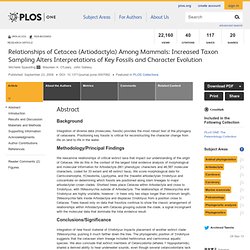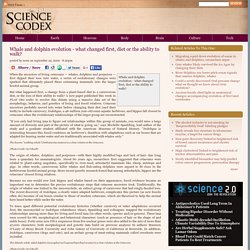

Relationships of Cetacea (Artiodactyla) Among Mammals: Increased Taxon Sampling Alters Interpretations of Key Fossils and Character Evolution. Introduction Establishing the position of Cetacea (whales, dolphins and porpoises) within Mammalia has long been a focus of mammalian systematists.

The transition from a primitively quadrupedal terrestrial ancestor to a convergently ‘fish-like’ modern mammal species involved changes in numerous character systems. Almost all anatomical systems of living cetaceans are highly modified for an aquatic lifestyle, with dramatic changes seen in areas such as the ear region, skin, limbs, and cranium relative to terrestrial mammals. The study of phylogenetic data that fossilizes (primarily skeletal and dental morphology) has been particularly important because it is by studying extinct species that we can reconstruct the order of character acquisition that led to the origin of Cetacea (see review of studies in [1], [2]).
Figure 1. Doi:10.1371/journal.pone.0007062.g001 Revised Taxonomy for Artiodactyla Table 1. Doi:10.1371/journal.pone.0007062.t001. Whale and dolphin evolution - what changed first, diet or the ability to walk? When the ancestors of living cetaceans — whales, dolphins and porpoises — first dipped their toes into water, a series of evolutionary changes were sparked that ultimately placed these swimming mammals into the larger hoofed animal group.

But what happened first, a change from a plant-based diet to a carnivorous diet, or the loss of their ability to walk? A new paper published this week in PLoS One seeks to resolve this debate using a massive data set of the morphology, behavior, and genetics of living and fossil relatives. Cetacean ancestors probably moved into water before changing their diet (and their teeth) to include carnivory; Indohyus, a 48-million year-old semi-aquatic herbivore, and hippos fall closest to cetaceans when the evolutionary relationships of the larger group are reconstructed.
The Eocene "walking whale"(Ambulocetus natans) is a close relative to the Cetacean. (Photo Credit: Carl Buell) "How do you put flesh and movement onto a fossil? " List of extinct cetaceans. The list of extinct cetaceans features the extinct genera and species of the order Cetacea. The cetaceans (whales, dolphins and porpoises) are descendants of land-living mammals, the even-toed ungulates.
The earliest cetaceans were still hoofed-mammals. These early cetaceans became gradually better adapted for swimming than for walking on land, finally evolving into fully marine cetaceans. This list currently includes only fossil genera and species. However, the Atlantic population of Gray Whales (Eschrichtius robustus) went extinct in the 18th century, and the Baiji (or Chinese River Dolphin, Lipotes vexillifer) was declared "functionally extinct" after an expedition in late 2006 failed to find any in the Yangtze River.
Suborder Archaeoceti[edit] Family Ambulocetidae[edit] (Eocene) Family Basilosauridae[edit] (Late Eocene) Family Kekenodontidae[edit] (Oligocene) Family Pakicetidae[edit] (Early to Middle Eocene) Family Protocetidae[edit] Family Remingtonocetidae[edit] Whale-eating sea monster uncovered in Peru. Leviathan melvillei chomps down on a baleen whale.

HIT PLAY, above, the see its fossilised teeth. Three lower teeth (a,b,c) of Leviathan melvillei compared to teeth of the modern sperm whale Physeter macrocephalus (d) and the modern killer whale Orcinus orca (e). Credit: G. Bianucci (Universitá di Pisa), O. Lambert (MNHN) and P. BRISBANE: A 12-million-year-old giant sperm whale, which was was one of the biggest raptorial predators of all time, has been discovered in Peru, researchers said. The now-extinct species had teeth up to 36 centimetres long and 12 centimetres across, and has one of the biggest bites ever discovered in vertebrates, according to a report today in the journal Nature. “This sperm whale could firmly hold large prey with its interlocking teeth, inflict deep wounds and tear large pieces from the body of the victim,” said lead author Olivier Lambert, a palaeontologist at the Royal Belgian Institute of Natural Sciences in Brussels, Belgium.
Giant whale had three metre skull.